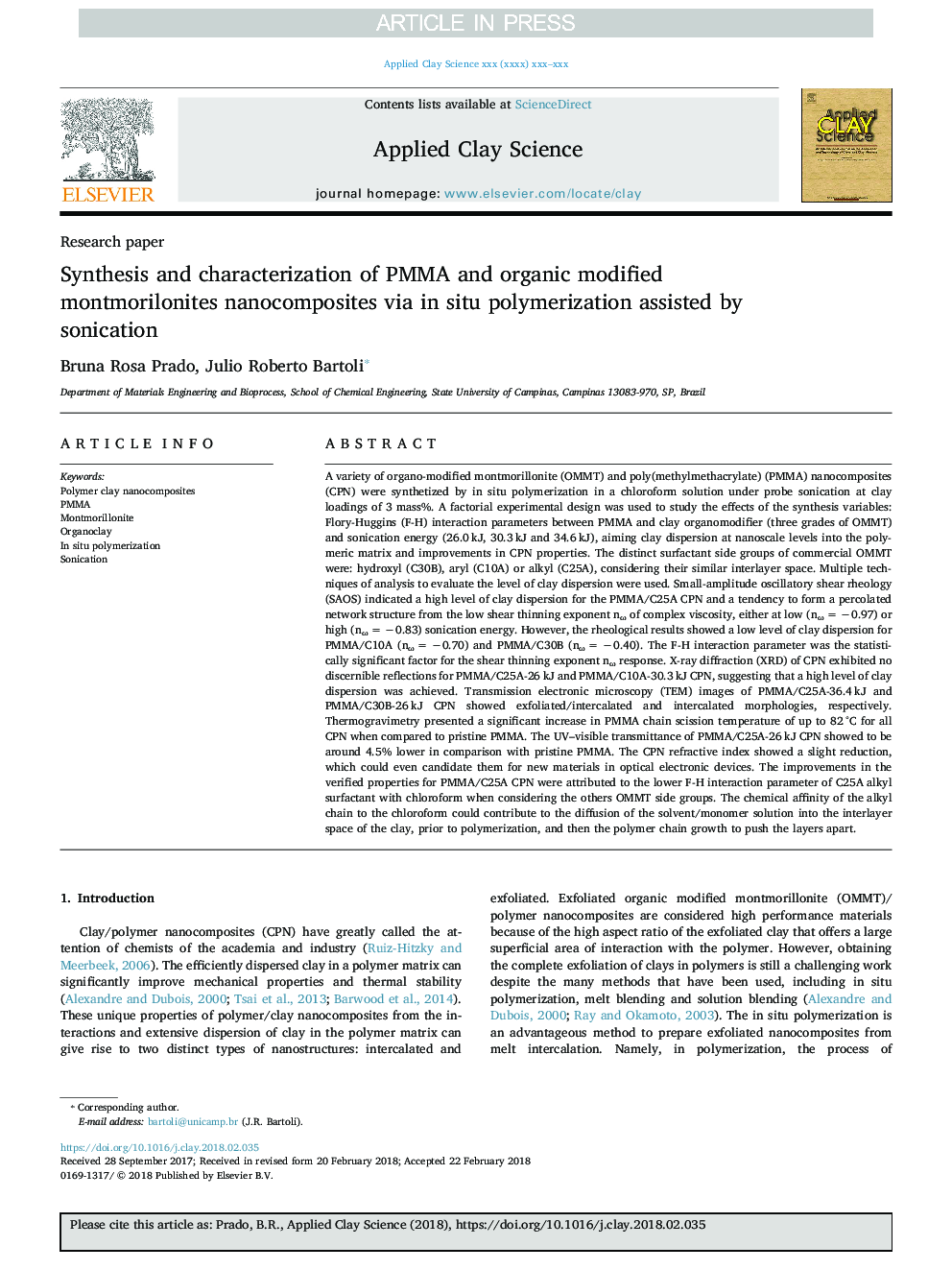| کد مقاله | کد نشریه | سال انتشار | مقاله انگلیسی | نسخه تمام متن |
|---|---|---|---|---|
| 8045859 | 1519028 | 2018 | 12 صفحه PDF | دانلود رایگان |
عنوان انگلیسی مقاله ISI
Synthesis and characterization of PMMA and organic modified montmorilonites nanocomposites via in situ polymerization assisted by sonication
دانلود مقاله + سفارش ترجمه
دانلود مقاله ISI انگلیسی
رایگان برای ایرانیان
کلمات کلیدی
موضوعات مرتبط
مهندسی و علوم پایه
علوم زمین و سیارات
ژئوشیمی و پترولوژی
پیش نمایش صفحه اول مقاله

چکیده انگلیسی
A variety of organo-modified montmorillonite (OMMT) and poly(methylmethacrylate) (PMMA) nanocomposites (CPN) were synthetized by in situ polymerization in a chloroform solution under probe sonication at clay loadings of 3 mass%. A factorial experimental design was used to study the effects of the synthesis variables: Flory-Huggins (F-H) interaction parameters between PMMA and clay organomodifier (three grades of OMMT) and sonication energy (26.0â¯kJ, 30.3â¯kJ and 34.6â¯kJ), aiming clay dispersion at nanoscale levels into the polymeric matrix and improvements in CPN properties. The distinct surfactant side groups of commercial OMMT were: hydroxyl (C30B), aryl (C10A) or alkyl (C25A), considering their similar interlayer space. Multiple techniques of analysis to evaluate the level of clay dispersion were used. Small-amplitude oscillatory shear rheology (SAOS) indicated a high level of clay dispersion for the PMMA/C25A CPN and a tendency to form a percolated network structure from the low shear thinning exponent nÏ of complex viscosity, either at low (nÏâ¯=â¯â0.97) or high (nÏâ¯=â¯â0.83) sonication energy. However, the rheological results showed a low level of clay dispersion for PMMA/C10A (nÏâ¯=â¯â0.70) and PMMA/C30B (nÏâ¯=â¯â0.40). The F-H interaction parameter was the statistically significant factor for the shear thinning exponent nÏ response. X-ray diffraction (XRD) of CPN exhibited no discernible reflections for PMMA/C25A-26â¯kJ and PMMA/C10A-30.3â¯kJ CPN, suggesting that a high level of clay dispersion was achieved. Transmission electronic microscopy (TEM) images of PMMA/C25A-36.4â¯kJ and PMMA/C30B-26â¯kJ CPN showed exfoliated/intercalated and intercalated morphologies, respectively. Thermogravimetry presented a significant increase in PMMA chain scission temperature of up to 82â¯Â°C for all CPN when compared to pristine PMMA. The UV-visible transmittance of PMMA/C25A-26â¯kJ CPN showed to be around 4.5% lower in comparison with pristine PMMA. The CPN refractive index showed a slight reduction, which could even candidate them for new materials in optical electronic devices. The improvements in the verified properties for PMMA/C25A CPN were attributed to the lower F-H interaction parameter of C25A alkyl surfactant with chloroform when considering the others OMMT side groups. The chemical affinity of the alkyl chain to the chloroform could contribute to the diffusion of the solvent/monomer solution into the interlayer space of the clay, prior to polymerization, and then the polymer chain growth to push the layers apart.
ناشر
Database: Elsevier - ScienceDirect (ساینس دایرکت)
Journal: Applied Clay Science - Volume 160, August 2018, Pages 132-143
Journal: Applied Clay Science - Volume 160, August 2018, Pages 132-143
نویسندگان
Bruna Rosa Prado, Julio Roberto Bartoli,